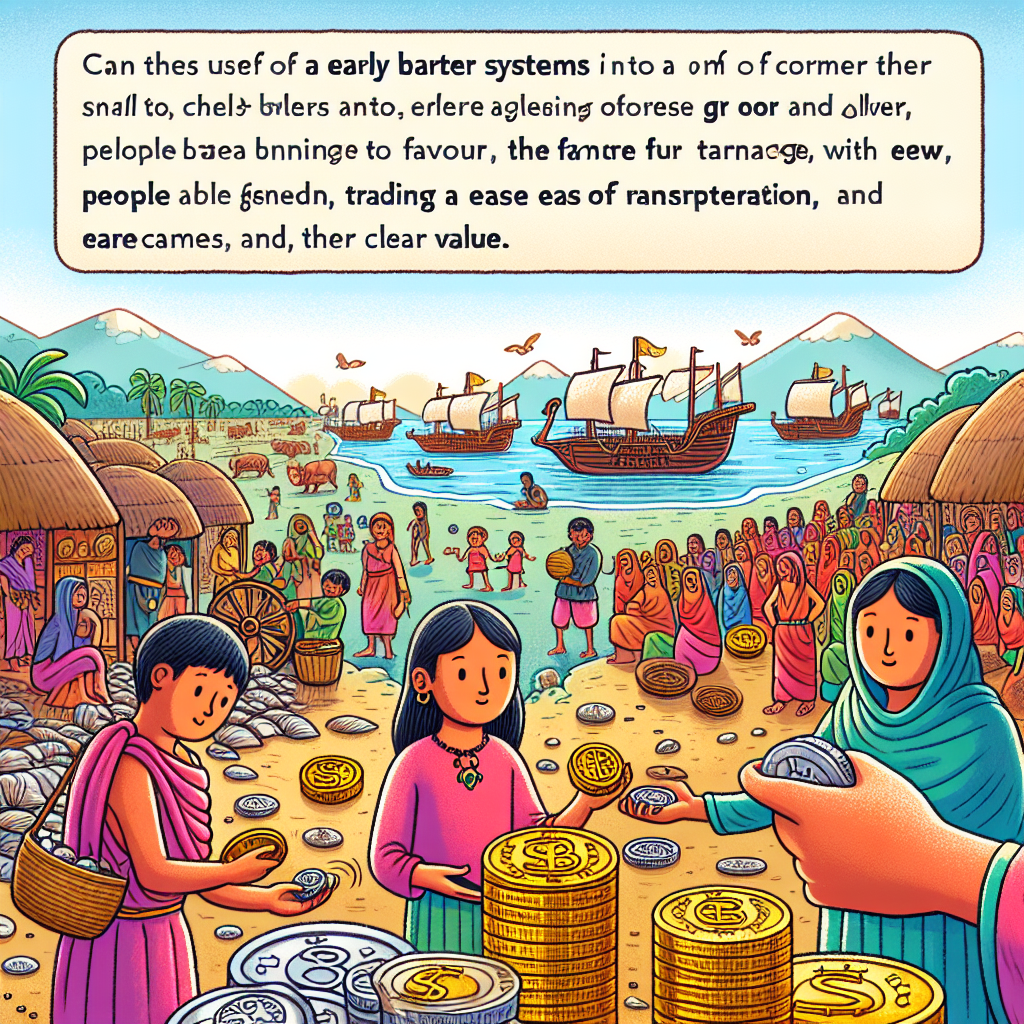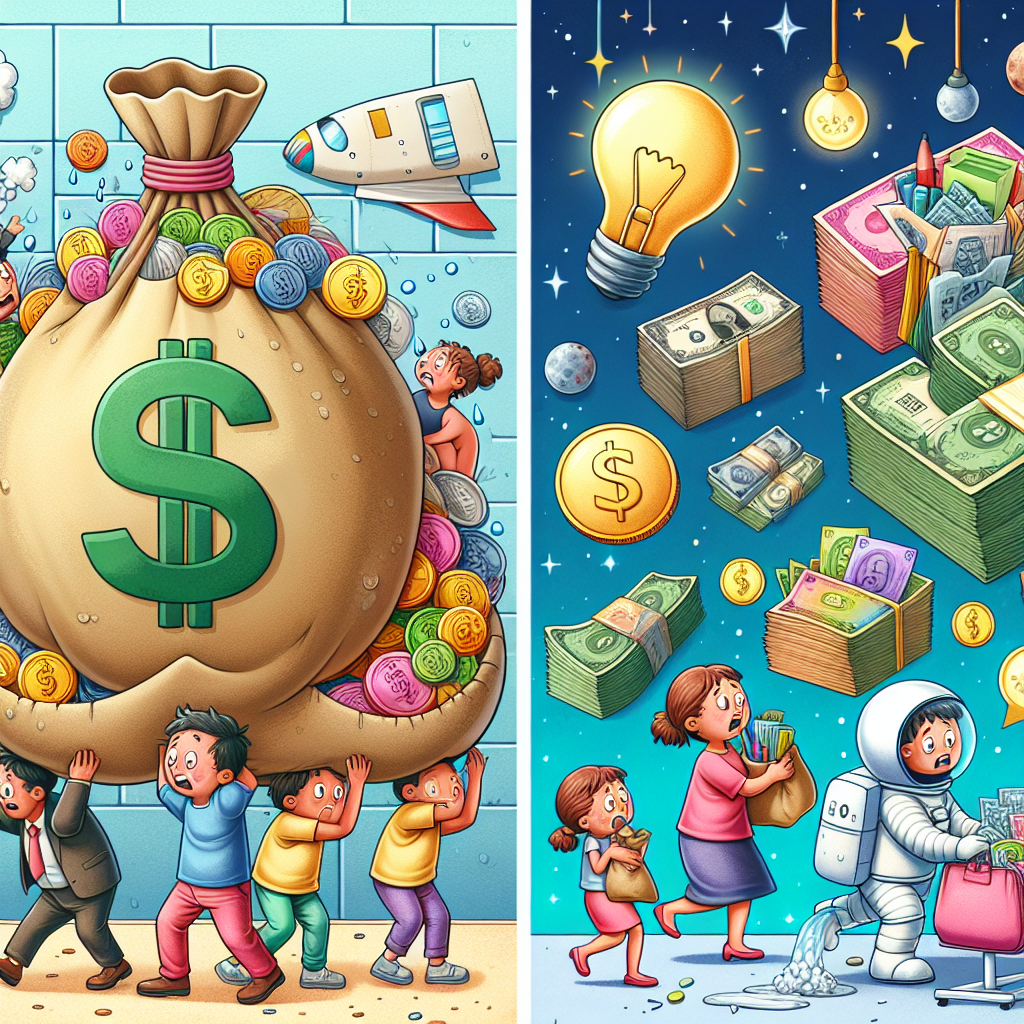Sample Personalized Lesson
This lesson was generated for a fictional person named Sue, 9 years old. Sue likes sandwiches, astronauts and wants to be a racecar driver. Her favorite animal is a dolphin, loves the ocean, legos and Kiwi fruits
From Barter to Banks: A Money Journey!
Listen to the Lesson
Coins and Castles: A Money Adventure!
Background
Remember how we learned about trading sandwiches for kiwi fruit and using cool shells as early money? Well, people got even smarter! They invented special, shiny bits of metal called coins to make trading super easy. Then, much later, we got paper money, and even special places called banks where we keep our money safe. Let's dive into how money changed and how it works today!
The Invention of Coins: Shiny Treasures!
- For a long time, early money like shells worked, but it still wasn't perfect.
- People started using pieces of special metals like gold and silver because they were rare, beautiful, and didn't spoil.
- They made these metals into small, round shapes and put special marks on them to show how much they were worth. These were the first coins!
- Coins made trading much simpler because everyone knew their value and they were easy to carry.
Real-World Example: Imagine Sue wants to trade for a special racecar part. Instead of hoping someone wants her kiwi fruit, she can just use a few shiny coins! It's much easier to carry a few coins than a pile of shells or a big block of salt.

Gold and Silver: The Original Coin Materials
- Gold and silver were chosen for coins because they were shiny, beautiful, and hard to find.
- When something is rare, it usually has more value.
- Plus, you could melt and reshape them, which was important!
Real-World Example: Just like finding a super rare, shimmering dolphin in the ocean is special, finding gold and silver was special! That's why people agreed they had a lot of value and made perfect material for coins.

From Coins to Paper: Modern Money!
- Carrying lots of heavy coins could be a hassle, especially for big trades!
- So, people invented paper money. It's much lighter and easier to carry large amounts.
- Paper money works because everyone trusts that it represents real value, even if it's just paper.
Real-World Example: Imagine an astronaut needs to buy a lot of supplies for a long space mission. Carrying giant bags of gold coins would be too heavy for the spaceship! Paper money is light and easy to manage, just like a small, folded map is easier to carry than a big book.

Banks: Safe Places for Our Money
- As people had more money, they needed a safe place to keep it. That's where banks came in!
- Banks are like big, super-secure safes where you can keep your money and know it won't get lost or stolen.
- When you put money in a bank, they keep track of it for you, and you can take it out when you need it.
Real-World Example: Sue loves making LEGO creations, and sometimes she has extra LEGO bricks. A bank is like a special box where she can keep those extra bricks safe until she needs them for a new project. You wouldn't want to leave your amazing LEGO spaceship out for anyone to take, right? Same with your money!
Money and Value: The Medium of Exchange
- Money is a medium of exchange. That's a fancy way of saying it's something everyone agrees to use to buy and sell things.
- It helps us easily trade our hard work or goods for other things we need or want.
- The value of money means how much something is worth. A big, yummy sandwich might have a different value than a cool toy dolphin. Money helps us compare those values.
Real-World Example: When Sue trades her sandwich for a kiwi fruit, that's barter. But with money, she can sell her sandwich for money, and then use that money to buy a kiwi fruit or a racecar toy or even save it for a trip to see real dolphins! Money is the special "go-between" that makes trading anything for anything else super simple.
Key Takeaway
People invented coins from valuable metals like gold and silver to make trading easier. Later, paper money was created, and banks became safe places to keep our money. Money is a medium of exchange that helps us trade because everyone understands its value.
Vocabulary List
- Coins – Small, flat, round pieces of metal used as money.
- Gold – A valuable, shiny yellow metal often used for coins and jewelry.
- Paper Money – Bills made of paper that represent value and are used as money.
- Banks – Special buildings where people keep their money safe.
- Medium of Exchange – Something (like money) that everyone agrees to use to buy and sell things.
Ready to Create Your Own Lessons?
Get personalized lessons tailored to your learning goals, track your progress, and master any subject with AI-powered content.
Sample Quiz Questions
Here are a few example questions that help reinforce the concepts from this lesson:
What made trading much simpler after coins were invented?
Answer: Everyone knew their value.
What were the first coins made from?
Answer: Gold and silver
What were the first coins made from?
Answer: Gold and silver
You Could Be Exploring Questions Like This
Create personalized lessons and get access to hundreds of quiz questions tailored to your learning style. Track your progress, test your knowledge, and master any subject at your own pace.
Start Your Learning Journey